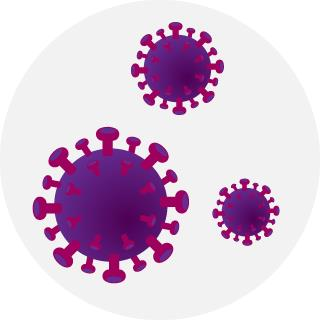Settings
Save and close

In support of our mission to bring cutting-edge mouse models and services to the global scientific community and promote human health, JAX has risen to the challenges resulting from the novel coronavirus pandemic.
Last year we announced the first COVID-19 mouse model, the K18-hACE2 transgenic mouse, which can be successfully infected with the SARS CoV-2 virus. This exclusive portfolio provides an in vivo platform for testing therapeutics, including recent preclinical testing of patient convalescent plasma, vaccines, monoclonal antibodies, as well as the studies involving co-infection of SARS-CoV-2 and influenza. We continue to offer this model at cost to keep this important research affordable and moving forward.
From prevention to studying the long term efforts of infection, JAX is the only place you can find the ideal solution for SARS CoV-2 and COVID-19 research needs.Compare the available models below. Speak to a JAX expert today!
Official Strain Nomenclature | Strain Number | Popular/Common Name | Action |
|---|---|---|---|
B6.Cg-Tg(K18-ACE2)2Prlmn/J | 34860 | K18-hACE2 |
NOD.Cg-Tg(K18-ACE2)2Prlmn Prkdcscid Il2rgtm1Wjl/J | 34901 | NSG K18-hACE2 | Pre-Order Now |
NSG.K18-hACE2 mice express human ACE2, the receptor used SARS-CoV2 to gain cellular entry. The addition of the NSG background may result in reduced immune response and increased susceptibility to SARS-CoV viral infection. In an attempt to offer alleles on well-characterized or multiple genetic backgrounds, alleles are frequently moved to a genetic background different from that on which an allele was first characterized. It should be noted that the phenotype of Stock No. 034901 could vary from that originally described for the C57BL/6 K18-hACE2 transgenic mice (Stock No. 034860). We may modify the strain description if necessary as published results become available. This K18-hACE2 transgene is also available on C57BL/6J genetic background as Stock No. 034860.
B6.Cg-Tg(K18-ACE2)2Prlmn Tg(FCGRT)32Dcr Fcgrttm1Dcr/J | 34902 | K18-hACE2 ; FcRn-/- hFcRn (32) Tg | Order Now |
K18-hACE2;FcRn-/-hFcRn(32)Tg mice expresses human ACE2 and human FcRn, and lacks the endogenous mouse FcRn gene. Expression of human ACE2 allows the SARS-CoV-2 virus to enter its target cells, and the replacement of the expression of mouse FcRn with its human counterpart provides researchers with an accurate prediction of antibody stability (Avery, et al, 2016; Tam, et al, 2013). Combining these two humanizations allows researchers to predict the ability of therapeutic monoclonal antibodies to block the spreading of SARS-CoV-2 infection in vivo.
B6.Cg-Tg(K18-ACE2)2Prlmn Ifnar1tm1.2Ees/J | 35041 | K18-hACE2 ; Ifnar1 | Order Now |
K18-hACE2 ; Ifnar1- mice express human ACE2 and a muation in Ifnar1 resulting in the knocout of the gene. Expression of human ACE2 allows for infection of mice with the SARS-CoV-2 virus; the knocout of Ifnar1 may result in reduced immune response and increased susceptibility to SARS-CoV-2 viral infection during preclinical studies.
C.Cg-Tg(K18-ACE2)2Prlmn/J | 35247 | K18-hACE2 on BALB/cJ | Register Interest |
BALBcJ.K18-hACE2 mice express human ACE2, the receptor used SARS-CoV2 to gain cellular entry. In an attempt to offer alleles on well-characterized or multiple genetic backgrounds, alleles are frequently moved to a genetic background different from that on which an allele was first characterized. It should be noted that the phenotype of Stock No. 035247 could vary from that originally described for the C57BL/6 K18-hACE2 transgenic mice (Stock No. 034860). We may modify the strain description if necessary as published results become available. This K18-hACE2 transgene is also available on C57BL/6J genetic background as Stock No. 034860.
B6.129S2(Cg)-Ace2tm1(ACE2)Dwnt/J | 35000 | hACE2-KI | Order Now |
hACE2-KI mice express human ACE2 in place of mouse Ace2 directed by the endogenous regulatory elements of the mouse Ace2 locus. High SARS-CoV2 viral variants loads were detected in nasal conchae and lungs of hACE2-KI mice, indicating this model supports efficient viral replication after infection. Additionally, strategically placed loxP sites around the hACE2 cDNA sequence allow for cre-recombination in a tissue-specific manner to delete hACE2 where desired. This model may be useful in examining the effects of SARS-CoV2 infection in one tissue or cell type while protecting another, and with the decreased severity may elucidate long-term effects of viral exposure.
C57BL/6-Ace2tm1.1(ACE2)Mdk/J | 35800 | humanized Ace2 KI, ACE2-GR | Order Now |
The endogenous mouse Ace2 gene is replaced by the human ACE2 gene in the ACE2-GR mice. These mice express human ACE2 in place of mouse Ace2.